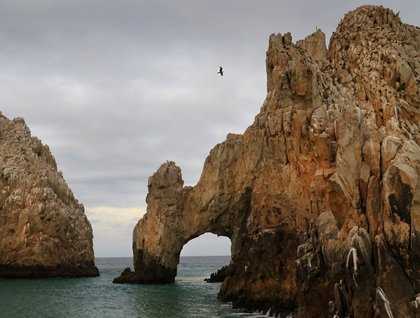Early risers crowded to the decks shortly after sunrise as National Geographic Sea Lion approached the very tip of the Baja Peninsula. The towering cliffs of granite known as Friar’s Rocks rose abruptly from the sea into a brooding sky of multi-shaded gray. Photographers sprang into action as Captain Dion deftly maneuvered our vessel for the perfect morning view of the world-famous arch that defines the region.
After a brief bus ride, people scattered to take advantage of a variety of options in town. Some chose to visit the mission or to investigate the many shops where one could scrutinize jewelry, clothing, knick-knacks and fine art pieces. Others opted for a guided stroll with an emphasis on photography or a stop for local ice cream. A glass-blowing facility offered demonstrations of the techniques used in their fascinating craft. Plantings of tropical plants from all over the world added splashes of color to the streets with bright orange blooms of African tulips, hot-magenta bracts of bougainvillea, and tabebuia trees blanketed in pale lavender blossoms.
One of the two buses dropped off a group at an estuary, a small stream that feeds into the sea. The paths that follow the water course are ideal for birdwatching, and our outing proved to be quite a success. Egrets, ibis, herons, and waterfowl foraged in the fresh water that is so limited in this arid environment. Orioles, doves, verdins, and warblers flitted within tree branches overhead. There are three species endemic to Baja California that we looked for, and with patience we happily located two: the Xantus’s hummingbird and the Belding’s yellowthroat. One dazzling hummer came within inches of several of us, providing an unexpected view.
At midday the ship pulled away from the dock and continued farther into the Sea of Cortez. Before long, humpback whale spouts rose in the distance. We spent the afternoon motoring on with welcome interruptions of whales along our way. Humpbacks are well-known for their surface-active behavior. At one site five individuals clustered together, acting like a competitive group of males. Pectoral flippers slapped like immense floppy wings, bodies launched above the surface in chin breaches, and flukes arched slowly and gracefully into the air, showing off the distinctive markings on the undersides of their tails as the animals sounded. By early evening it was time to leave these impressive humpbacks behind and head for tomorrow’s destination and more adventures on our Remarkable Journey.







